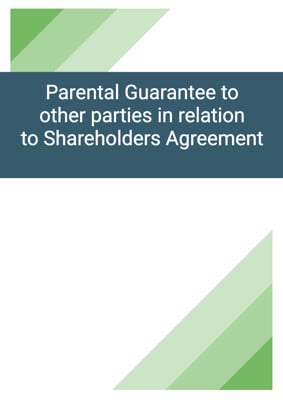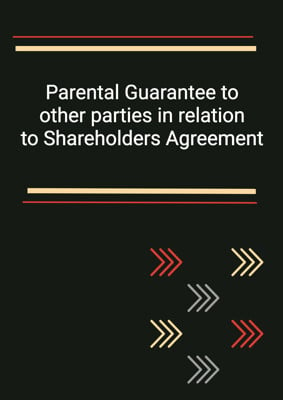How to Tailor the Document for Your Need?
01
Create Document
Fill in the details of the parties. You can click the "Fill with Member’s Information" button to complete it with information saved to your account.
02
Fill Information
Please fill in any additional information by following the step-by-step guide on the left hand side of the preview document and click the "Next" button.
03
Get Document
When you are done, click the "Get Document" button and you can download the document in Word or PDF format.
04
Review Document
Please get all parties to review the document carefully and make any final modifications to ensure that the details are correct before signing the document.
Document Preview
Document Description
This shareholders agreement is a legally binding document that governs the relations between the parties as shareholders in a jointly-owned company. The agreement highlights the importance of forming a new company and acquiring certain rights and assets. It sets out the terms and conditions that will regulate the shareholders' rights and obligations.
The agreement begins with an interpretation section that defines key terms used throughout the document. It provides definitions for terms such as party 1 director, party 1 shares, party 2 director, party 2 shares, and so on. This ensures clarity and understanding when referring to these terms later in the agreement.
The document then proceeds to outline the process of establishing the company. It specifies the requirements for incorporation, including the company's name, authorized share capital, and registered office. The completion of the establishment is also detailed, including the subscription and payment for shares by each party, the allotment and issuance of shares, and the execution of ancillary agreements.
Next, the agreement addresses the capital and further finance of the company. It states the share capital of the company and allows for the increase of share capital by agreement of the parties. It also outlines the process for providing further finance to the company if needed.
The section on directors and management establishes the board of directors and their roles. It specifies the appointment and removal of directors by each party and outlines the quorum and voting procedures for board meetings. The notice and agenda requirements for board meetings are also included.
The agreement then covers reserved shareholder matters that require the prior approval of the parties. These matters include issues such as the issuance of shares, sale of the company, alteration to the memorandum and articles, borrowing by the company, and approval of the annual budget and operating plan.
The transfer of shares section outlines the process for transferring shares between parties. It includes provisions for transfer notices, purchase notices, determination of fair price, and the right to sell shares to a third party if not purchased by the continuing party.
Confidentiality provisions are included to protect sensitive information related to the company and the parties. The agreement restricts the parties from disclosing or using such information except as necessary for advancing the business.
The agreement also includes restrictions on the parties from engaging in competing businesses during the term of the agreement. This ensures that the parties focus on the success of the jointly-owned company and avoid conflicts of interest.
The term section specifies the minimum duration of the agreement and allows for termination by either party with prior notice. It also addresses the liquidation of the company upon termination.
The agreement emphasizes its supremacy over the memorandum and articles of the company, stating that this agreement prevails in case of any conflict.
Costs related to the incorporation of the company are to be borne by the company, while each party is responsible for its own costs in preparing and executing the agreement.
The agreement clarifies that it does not create a partnership or agency relationship between the parties. Each party is independent and cannot commit or bind the other party.
The entire agreement clause confirms that this document, along with any other agreements entered into on completion, constitutes the entire agreement between the parties. It states that no party has relied on any representations or warranties not expressly set out in the agreement.
The assignment clause prohibits the parties from assigning their rights or obligations under the agreement without the proper transfer of shares in accordance with the transfer provisions.
If applicable, the conditions precedent section outlines the conditions that must be fulfilled or waived before completion of the agreement. It specifies that if the conditions are not met, the agreement automatically terminates.
The amendment clause requires any variations to the agreement to be in writing and signed by the parties. It clarifies that variations do not constitute a waiver of any provisions and do not affect rights and obligations that have already accrued.
The agreement states that it does not confer any rights on third parties, meaning that only the parties to the agreement can enforce its terms.
The dispute resolution clause provides for the jurisdiction of any legal proceedings arising from the agreement.
The notices and service section outlines the requirements for giving notice under the agreement. It specifies the methods of service, such as delivery by hand, email, fax, or registered post. It also includes the addresses and contact details of the parties for the purpose of notice.
Finally, the agreement is signed by the duly authorized representatives of the parties, indicating their acceptance and commitment to the terms and conditions outlined in the document.
How to use this document?
To use this shareholders agreement effectively, follow these steps:
1. Incorporation: Ensure that the company is incorporated in accordance with the agreed characteristics outlined in the agreement. This includes selecting a suitable name, preparing the memorandum and articles, and determining the authorized share capital.
2. Completion: Complete the establishment of the company by subscribing for shares and paying for them in cleared funds. Allot and issue the shares to the respective parties and enter into the agreed form ancillary agreements.
3. Capital and further finance: Understand the share capital structure of the company and the possibility of increasing it by agreement. If further finance is required, approach the company's own bankers first. If necessary, provide finance in equal proportions and determine the terms of such finance.
4. Directors and management: Appoint directors to the board in accordance with each party's entitlement. Ensure that the board is constituted by directors appointed by each party. Follow the quorum and voting procedures for board meetings and provide proper notice and agenda for such meetings.
5. Reserved shareholder matters: Obtain prior approval from the parties for any matters listed as reserved shareholder matters. This includes issues such as issuing shares, selling the company, altering the memorandum and articles, and approving the annual budget and operating plan.
6. Transfer of shares: Adhere to the transfer provisions when a party desires to sell or dispose of shares. Serve a transfer notice to the other party, who then has the option to purchase the shares or determine a fair price. Complete the sale and purchase of shares accordingly or allow the selling party to sell to a third party if not purchased.
7. Confidentiality: Maintain strict confidentiality regarding any information acquired in relation to the company or the other party. Use such information only in the ordinary course of advancing the business and ensure that employees and agents also observe this obligation.
8. Restrictions on the parties: Avoid engaging in any competing business during the term of the agreement. Focus on the success of the jointly-owned company and refrain from activities that may create conflicts of interest.
9. Term and termination: Respect the minimum duration of the agreement and provide prior notice if either party wishes to terminate. Upon termination, cooperate to ensure the completion of any outstanding contracts and propose liquidation of the company if necessary.
10. Supremacy of the agreement: Ensure that the provisions of this agreement are duly performed and take precedence over the memorandum and articles of the company. Use votes and other means to enforce the agreement's terms.
11. Costs: Understand that the costs of incorporating the company are borne by the company itself. Each party is responsible for its own costs related to preparing and executing the agreement.
12. No partnership or agency: Remember that this agreement does not create a partnership or agency relationship between the parties. Each party remains independent and cannot commit or bind the other party.
13. Entire agreement: Recognize that this agreement, along with any other agreements entered into on completion, constitutes the entire agreement between the parties. Rely only on the representations and warranties expressly set out in the agreement.
14. Assignment: Refrain from assigning this agreement or any rights or obligations under it without proper transfer of shares in accordance with the transfer provisions.
15. Conditions precedent (if applicable): Ensure that all conditions precedent are fulfilled or waived before completion of the agreement. If any conditions are not met, the agreement automatically terminates.
16. Amendment: Understand that any variations to the agreement must be in writing and signed by the parties. Variations do not waive any provisions and do not affect rights and obligations that have already accrued.
17. No rights of third parties: Remember that only the parties to this agreement have the right to enforce its terms. Third parties do not have any rights under this agreement.
18. Dispute resolution: Adhere to the agreed jurisdiction for any legal proceedings arising from the agreement. Respect the requirements for giving notice under the agreement, including the specified methods of service and contact details of the parties.
By following these steps, you can effectively use this shareholders agreement to govern the relations between the parties as shareholders in the jointly-owned company.


























